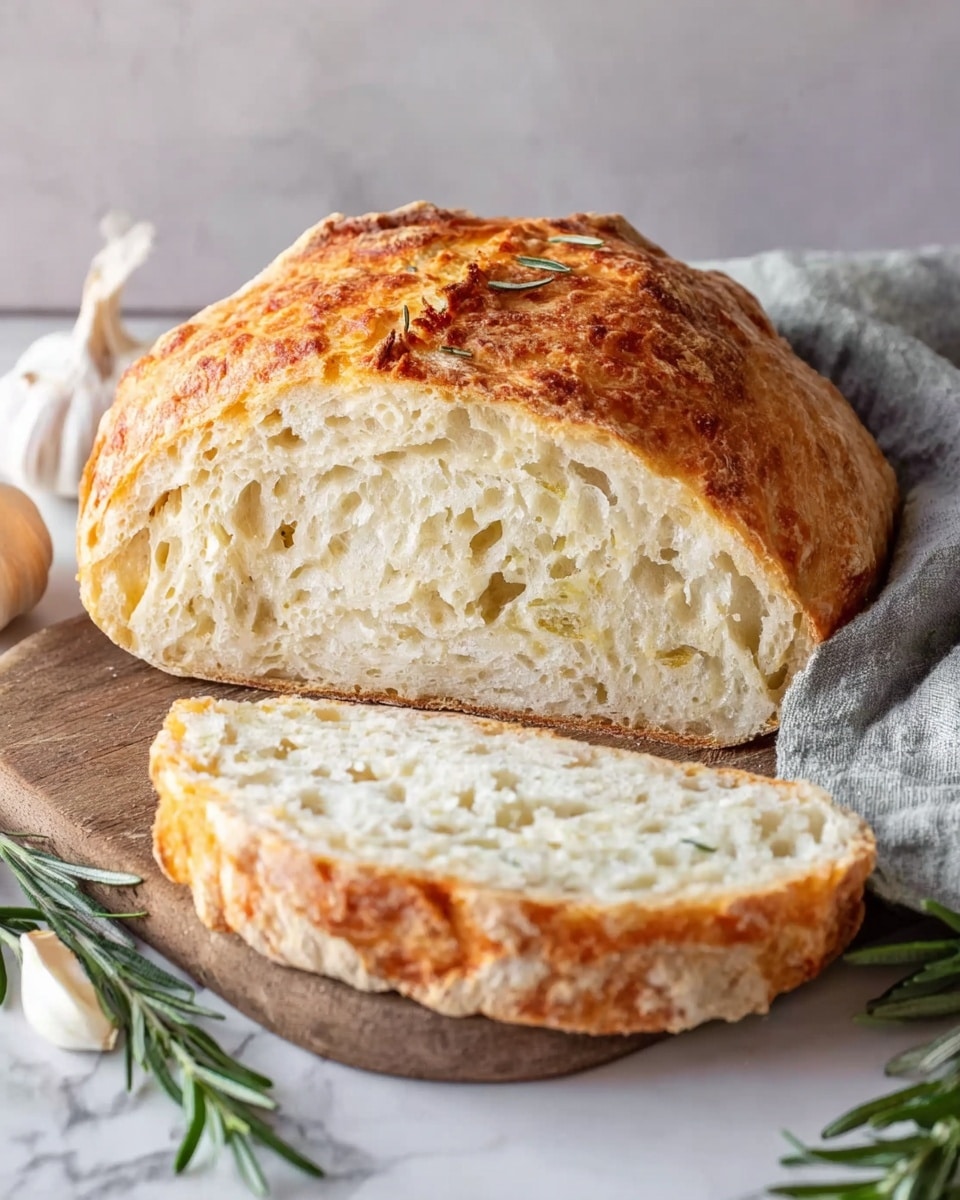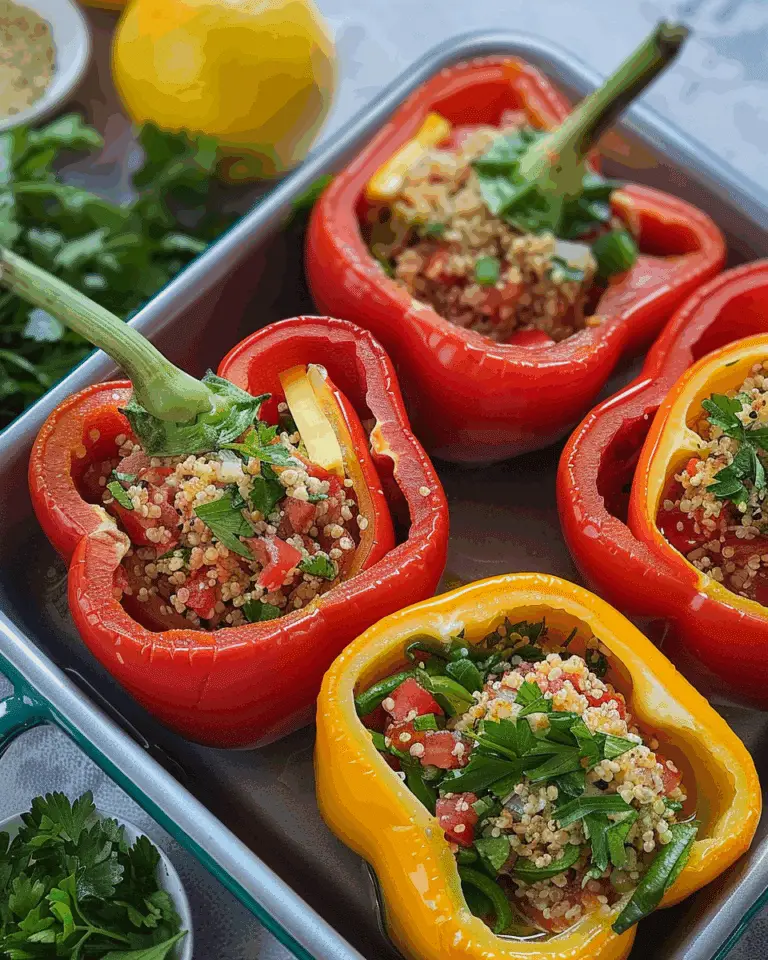“`html
If you’ve ever dreamed of pulling a warm, fragrant loaf fresh from your own Dutch oven, then this Dutch Oven Garlic Rosemary Bread Recipe is about to become your new obsession. Imagine a crusty, golden exterior with an irresistibly soft, garlic- and rosemary-infused crumb inside that fills your kitchen with comforting aromas. Whether you’re a seasoned baker or just stepping into the world of homemade bread, this recipe is delightfully simple and yields a proud, rustic loaf that’s perfect any time of the day.
Ingredients You’ll Need

This delicious bread only calls for a handful of essential ingredients, each bringing something special to the loaf. From the robust aroma of fresh rosemary to the gentle sweetness of sugar, every element plays a vital role in crafting this stunning bread.
- 3 cups All Purpose Flour: The backbone of the bread, providing structure and body.
- 1 1/2 tsp sugar: Just a touch to feed the yeast and soften the flavor.
- 2 tsps salt: Enhances taste and balances the sweetness.
- 2 1/2 tsp quick yeast (1 package): The magic that makes the bread rise and become fluffy.
- 1 1/3 cups warm water: Activates the yeast and brings the dough to life.
- 2 large rosemary sprigs, diced: Fresh herbiness that infuses every bite.
- 3 garlic cloves, diced: Adds a savory kick, perfectly complementing the rosemary.
How to Make Dutch Oven Garlic Rosemary Bread Recipe
Step 1: Mix Your Ingredients
Start by combining all your ingredients into a large mixing bowl. The dough will look sticky and shaggy — that’s exactly what you want. This texture sets the foundation for an airy crumb inside your loaf, so don’t be tempted to add extra flour. Give it a good stir to ensure everything is evenly incorporated before letting it rest.
Step 2: First Rise
Cover the bowl with a towel and allow the dough to rise for 60 minutes. If you have a proof setting on your oven, that’s the perfect cozy spot. Otherwise, placing it near a warm air vent or simply turning your oven on briefly and closing the door works wonderfully. This rest time nurtures your yeast and helps your bread develop flavor and texture.
Step 3: Shape the Dough
Once risen, dump your dough out onto parchment paper dusted with flour. Using your hands, stretch and fold the dough into a rough ball shape – no tricky maneuvers needed here! Flip it so the smooth side faces up, then cover with a towel and let it relax for another 20 minutes. Meanwhile, you can get your Dutch oven preheating.
Step 4: Preheat the Dutch Oven
Place your empty Dutch oven (without the lid) inside your regular oven and preheat it to 450°F. The intense heat from the pot will help create the iconic crispy crust, mimicking a professional bakery oven.
Step 5: Bake Your Bread
Carefully remove the scorching hot Dutch oven using oven mitts. Transfer your dough ball along with the parchment paper into the pot. Using a knife, score the dough with one long slash down the center—this lets steam escape and adds beautiful texture. Cover with the lid and bake for 30 minutes.
Step 6: Final Browning
After 30 minutes, remove the lid and bake for another 10 minutes or until your loaf is golden brown and crusty. Don’t rush this step; that crunchy crust is what makes this Dutch Oven Garlic Rosemary Bread Recipe truly spectacular.
Step 7: Cooling
Lift your bread out of the Dutch oven using the parchment paper and let it cool on a rack or cutting board for at least 30 minutes. Waiting is the hardest part, but it allows the crumb to set perfectly.
How to Serve Dutch Oven Garlic Rosemary Bread Recipe

Garnishes
This bread shines simply with a slather of good butter and a sprinkle of flaky sea salt, but you can also drizzle it with extra virgin olive oil and a splash of balsamic vinegar for a delightful snack. A fresh grind of black pepper complements the garlic and rosemary beautifully if you want a little peppery kick.
Side Dishes
It pairs wonderfully with soups and stews, especially hearty tomato soup, creamy mushroom bisque, or a zesty chili. Serve alongside a cheese platter or a bright salad for an elegant yet rustic meal that everyone will rave about.
Creative Ways to Present
Try slicing the bread and toasting it to create crostini topped with goat cheese and a drizzle of honey or fresh tomatoes and basil for a crowd-pleasing appetizer. Alternatively, use it to make a gourmet grilled cheese sandwich with caramelized onions and gruyere cheese—pure bliss!
Make Ahead and Storage
Storing Leftovers
Keep your leftover bread fresh by wrapping it in a clean kitchen towel and placing it in a bread box or paper bag at room temperature. Avoid plastic bags as they trap moisture and soften the crust. This way, your bread should stay delicious for up to two days.
Freezing
If you want to save the loaf for longer, slice it and store the slices in an airtight freezer bag. When you’re ready to enjoy, you can toast the slices straight from the freezer, enjoying that freshly baked flavor any time.
Reheating
To bring back that fresh-baked feeling, pop the bread in a preheated oven at 350°F for 5 to 10 minutes. This warms the crumb and crisps up the crust, making it taste like it just came out of the Dutch oven again.
FAQs
Can I use fresh yeast instead of quick yeast?
You can, but you’ll need to adjust the quantity — typically fresh yeast requires about three times the amount of instant yeast. Also, dissolve it in water first and allow it to bloom before mixing into the flour. The quick yeast keeps this Dutch Oven Garlic Rosemary Bread Recipe super simple and fast.
Is it necessary to preheat the Dutch oven?
Yes! Heating the Dutch oven before baking is key to developing the perfect crust. The hot walls create steam and an intense heat environment that mimics a professional bread oven.
Can I add other herbs or ingredients?
Absolutely! Feel free to customize by adding thyme, oregano, or even sun-dried tomatoes for a unique twist. Just be mindful not to overload the dough to keep its structure intact.
Why is my bread dense and heavy?
This usually means the dough didn’t rise enough or the yeast was inactive. Be sure your water is warm (not hot) to activate the yeast, and give your dough plenty of time in a warm place to rise properly.
How do I know when the bread is done?
Look for a deep golden crust and lightly tap the bottom of the loaf—it should sound hollow. If using a thermometer, the internal temperature should be about 200°F for perfect doneness.
Final Thoughts
I can’t recommend this Dutch Oven Garlic Rosemary Bread Recipe enough — it’s straightforward, satisfying, and yields a loaf you’ll be proud to call your own. There’s nothing quite like the joy of homemade bread filling your kitchen with fragrant warmth. Give it a try, and soon enough, this beautiful bread will become a beloved staple in your home too!
“`
PrintDutch Oven Garlic Rosemary Bread Recipe
This Dutch Oven Garlic Rosemary Bread is a wonderfully comforting homemade bread recipe featuring fragrant garlic and fresh rosemary. Baked in a hot Dutch oven, this bread develops a crisp golden crust with a tender, aromatic interior. Ideal as a side dish or snack, it’s simple to prepare and truly satisfying.
- Prep Time: 1 hour 5 minutes
- Cook Time: 40 minutes
- Total Time: 2 hours 15 minutes
- Yield: 8 slices
- Category: Side Dish
- Method: Baking
- Cuisine: American
Ingredients
Dry Ingredients
- 3 cups All Purpose Flour
- 1 1/2 tsp sugar
- 2 tsp salt
- 2 1/2 tsp quick yeast (1 package)
Wet Ingredients
- 1 1/3 cups warm water
Flavorings
- 2 large rosemary sprigs, leaves removed and diced
- 3 garlic cloves, diced
Instructions
- First Rise: Add all of the ingredients—flour, sugar, salt, yeast, warm water, rosemary, and garlic—to a mixing bowl and stir together. The dough will be sticky and shaggy, which is expected. Cover the bowl with a towel and let the dough rise for 60 minutes in a warm place such as a proofing oven, a warm oven, or near warm air vents.
- Shaping the Bread: Lay a piece of parchment paper on a surface and dust it with flour. Transfer the dough onto the paper and shape it by stretching each side and folding it over until it forms a round ball. Flip the dough so the smooth side is on top. Cover it with a towel and let it rise again for about 20 minutes, while you preheat the oven and Dutch oven.
- Heating the Dutch Oven: Place the Dutch oven (without lid) in your oven and preheat to 450°F (232°C). Allow the Dutch oven to reach temperature as the dough completes its second rise.
- Baking the Bread: Using oven mitts, carefully remove the hot Dutch oven from the oven and place it on the stove top. Lift the dough using the parchment paper and transfer it into the Dutch oven. Score the top of the dough with a sharp knife to allow steam to escape during baking. Cover with the lid and bake for 30 minutes. After 30 minutes, remove the lid and bake for an additional 10 minutes or until the bread is golden brown and crusty on top.
- Cooling: Remove the bread from the Dutch oven using the parchment paper and place it on a cooling rack. Let cool for at least 30 minutes before slicing and serving.
Notes
- Use warm water, around 100°F (38°C), to activate the yeast properly.
- Be careful when handling the hot Dutch oven to avoid burns.
- Scoring the bread can be done with artistic designs or a simple slash; it helps control bread expansion and steam release.
- Letting the bread cool completely before slicing improves texture and prevents it from becoming gummy.
- For serving, try butter with sea salt, olive oil with balsamic vinegar, or enjoy plain.








